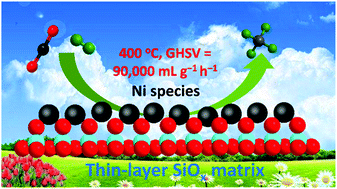Efficient conversion of CO2 to methane using thin-layer SiOx matrix anchored nickel catalysts†
Abstract
Hydrogenation of CO2 toward methane is a promising alternative for CO2 utilization and the development of highly efficient catalysts is the key factor for CO2 methanation. Herein, thin-layer SiOx matrix anchored nickel species catalysts (Ni/SiOx) with high specific surface area and a unique electronic/geometric structure have been successfully fabricated via a hydrothermal strategy. Ni3Si2O5(OH)4, with a typical layered structure and uniformly dispersed nickel sites, is an ideal precursor for Ni/SiOx catalysts for enhanced CO2 adsorption and chemical activation. The highly dispersed Ni active sites with suitable metal-support interactions with the SiOx matrix can promote CO2 conversion. Moreover, the pore structure and surface physicochemical properties of the Ni/SiOx samples can be tuned by changing the Ni/Si molar ratio. The optimized Ni/SiOx-2 catalyst shows outstanding catalytic efficiency with CO2 conversion of 64.2% and CH4 selectivity of 91.4% as well as excellent long-term (200 h) thermal stability for CO2 methanation under the conditions of 400 °C and the high gas hourly space velocity (GHSV) of 90 000 mL gcat−1 h−1. These findings can open new avenues towards the development of new-type nanomaterials in catalysis, especially renewable C1 chemistry transformations.



 Please wait while we load your content...
Please wait while we load your content...